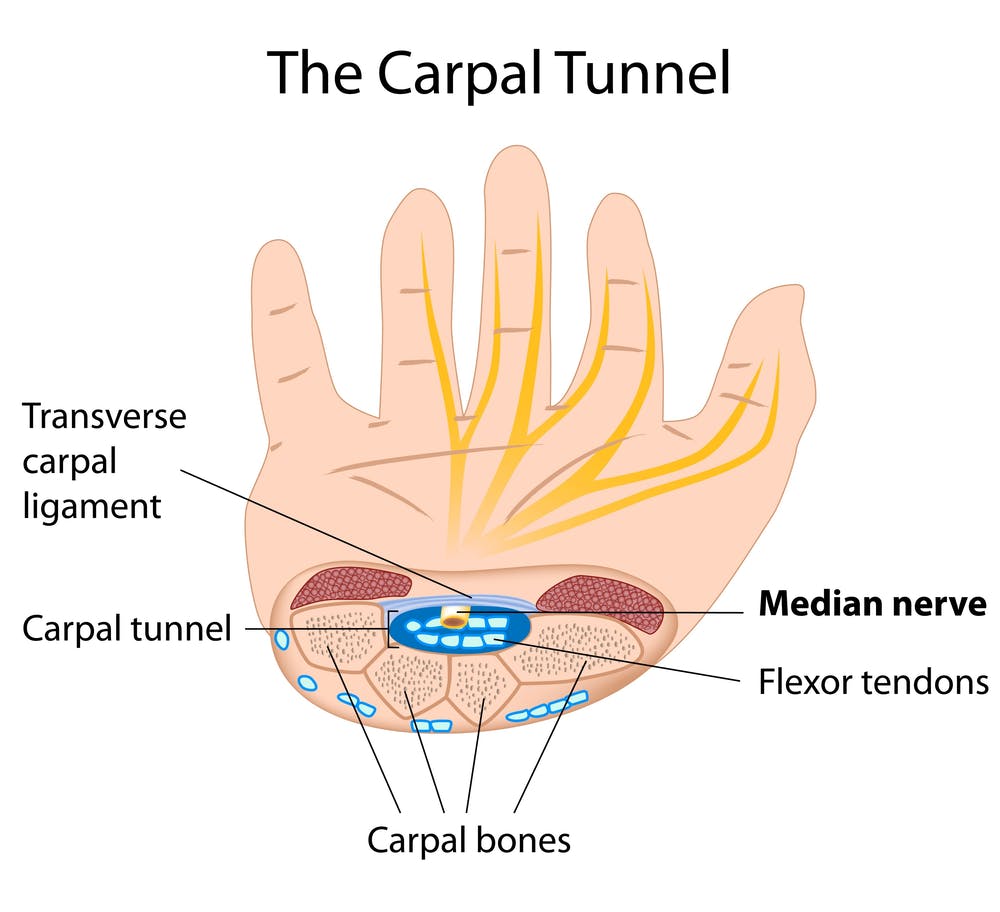It’s been a long day at the office, the kids are fed, bathed, and down for the night, and it’s time for my head to hit the pillow. Exhausted doesn’t cut it, but I still cannot sleep… What is this tingling in my fingers and wrist pain I keep getting? Enter Carpal Tunnel.
Wrist pain is quite common, and one of the most common causes for pain over the palm side of the wrist and hand is Carpal Tunnel Syndrome (CTS).
CTS presents when one of the larger nerves that travels from your shoulder down to the tip of your fingers (it’s called the Median nerve) gets compressed as it passes through the wrist. The ‘tunnel’ is a small space in the wrist, made up on one side by the wrist bones (the ‘carpals’), and a soft tissue covering on the other side. Alongside the nerve travels a group of tendons from the forearm, and once all of that has passed through the tunnel, there isn’t a lot of room for anything else. Throw in a heap of repetitive wrist movements over a prolonged period (for example typing at a desk day in, day out), and the structures running through the tunnel can become irritated and inflamed making an already small space even smaller. Once the nerve becomes compressed, symptoms start to creep in.
Signs and symptoms of Carpal Tunnel
CTS can be characterised by the following signs and symptoms:
- Burning wrist pain (on the palm side of the wrist)
- Numbness, pins & needles or tingling of the thumb, index, middle and inside part of the ring finger
- Night time symptoms
- Pain that radiates to the forearm, elbow or even the shoulder
- Reproduction of symptoms when compressing or tapping over the palm side of the wrist
As well as repetitive motions of the wrist (seen commonly in desk-based workers, sports people, and even our very own manual therapists), CTS can be caused by some underlying conditions, such as Diabetes Mellitus, Thyroid disease, Rheumatoid Arthritis, high blood pressure, and from fluid retention associated with pregnancy or menopause. Trauma or fractures in the wrist may also lead to this condition. Unfortunately, if you are female, you are also three times more likely to experience this problem.

How can I treat it?
If caught early, this problem can be managed conservatively with a combination of the following treatments:
- Soft tissue release, joint mobilisation/manipulation
- Anti-inflammatory medication
- Splinting of the wrist (particularly at night time)
More severe and persistent cases may require more invasive treatments including having a steroid injection, or possibly surgery to decompress the nerve.
If you have wrist pain, and you think it could be CTS, then our best advice is to visit us here at OsteoWest Health and Sports Clinic, where you can be assessed thoroughly, diagnosed accurately, and given the best advice and tools to manage your problem. We’ll get you waving goodbye (pain-free) to pain in no time!
References:
1. Brukner & Khan’s Clinical Sports Medicine Volume 1 – Injuries (5th ed) – ISBN 978-1743761380
2. Wipperman, J and Goerl, K, 2016. Carpal Tunnel Syndrome: Diagnosis and Management. American Family Physician. 94 (12).
